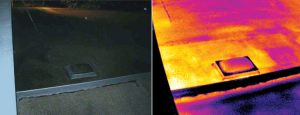When arranging a new roof project, you have a lot to worry about from hiring a contractor to making sure everyone is safe. It’s important to work with your contractor in taking the proper precautions to protect your people and adjacent property.
Here at West Roofing Systems, we’ve been installing Spray Polyurethane Foam Roofs for over 37 years. And in that time, we’ve worked with customers to keep not only their new roof looking good, but their commercial property safe and clean.
What is Spray Polyurethane Foam?
Spray Polyurethane Foam, more commonly referred to as SPF, is a material that is sprayed and expands into a foam, creating a stable layer across an existing roof.
While SPF roofing is not the most known type of roofing material, the technology has been around since the early 1960s for industrial, commercial, and residential facilities.
[caption id="attachment_25022" align="alignright" width="300"]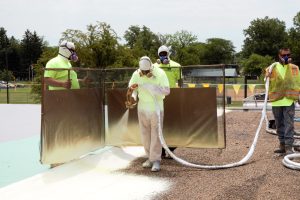 SPF Installation[/caption]
SPF Installation[/caption]
Read More: Spray Polyurethane Foam (SPF) Roofing: Installation & Performance
Before the installation can start, the existing roof needs to be prepared. Rather than stripping the existing roof, the contractor will most likely prepare the substrate by getting rid of all dirt, dust, and contaminants.
The first layer put down by the contractor is the polyurethane foam. This foam is created by combining two liquids as it’s sprayed onto the existing roof substrate. As the liquid is sprayed onto the existing roof, it expands to form a solid foam surface.
When the SPF layer has been completed, it is then coated with a layer(s) of elastomeric silicone or acrylic coating with embedded granules.
What is SPF Overspray?
Spray Polyurethane Foam is installed as a liquid and expands into a foam, SPF overspray happens when the fluid is carried by the wind and lands on surrounding property and expands to foam. The result looks like varying size white spots. While not ideal, it is rather easy to prevent and clean up overspray.
How to Avoid SPF Overspray
It’s in everyone’s best interest to invest the time and energy to prevent and avoid overspray during an SPF Roof Application.
Here are a few ways that you and your contractor can prevent overspray:
Check the Wind
It’s a good idea to check the wind strength and direction before your contractor begins spray polyurethane. If you can tell what direction the wind is blowing, you can take extra precautions. Some companies will use a windsock.
Clear & Barricade the Parking Lot
[caption id="attachment_25274" align="alignright" width="300"] Covering nearby vehicles with car covers during the project[/caption]
Covering nearby vehicles with car covers during the project[/caption]
One of the most common overspray problems companies has overspray on nearby cars. Since they are working on a roof, the SPF is carried down to the adjacent parking lot. You can prevent this from happening a few days:
- Evacuating and barricading the parking lot to keep cars at a safe distance
- Covering nearby vehicles with car covers during the project
Evacuate the Area
Anything that can be moved should be moved to inside storage or a safe distance from the worksite.
Mask Items That Can’t Be Moved
When large items and equipment can’t be moved, you can use tape, plastic, paper, burlap, mesh or boards to cover and protect them.
Windscreen
Your SPF contractor should have and use windscreens during the application process. These are transportable and can be held up by a team around where the SPF is being prayed. In some instances, your contractor can use an enclosure made of mesh, such as a Kwik Book, for total protection.
- One person screen can be used in the light wind from one direction
- two person screen can be used in slightly higher winds
- Total enclosure on wheels adds the best protection
How to Clean Up SPF Overspray
Cars
 It may be a shock to see all of the white spots on your vehicle. Fortunately, it looks worse than it is, overspray does not damage your car or paint. If left alone, the foam will disintegrate on its own with the sunlight in about a few weeks.
It may be a shock to see all of the white spots on your vehicle. Fortunately, it looks worse than it is, overspray does not damage your car or paint. If left alone, the foam will disintegrate on its own with the sunlight in about a few weeks.
But you can take your car to a detailing company to have the foam removed, usually with a clay bar to remove the overspray from paint and a razor to remove it from the glass. Make sure to contract the SPF contractor prior to having the work done so that all parties are aware of the damage and the agreed upon expense for the repair.
Landscaping
Depending on the severity of overspray, you usually don’t need to replace plants within your landscaping.
The simplest recourse is just to allow the foam to degrade in about a few weeks. If some areas have more visible overspray, you can trim leaves or branches.
Windows
Most of the time, any windows that are at risk for overspray will be covered. If overspray does land on windows, you can take the same approach as a car by scraping the foam off with a razor blade.
The energy efficiency and environmental sustainability can lead to lower life-cycle costs to install and maintain an SPF roofing system. When installing an SPF roofing system, in some instances, there is no need to strip the existing roof. This saves money on labor and debris removal. The longevity of a properly maintained system can be beneficial in the long run when there is no need for replacement.
Spray Polyurethane Foam Roofing Systems are becoming the go-to roofing for commercial, industrial, and even residential facilities that are looking for a long-lasting, economically efficient option. As the cost of energy increases, so will the demand for SPF roofs.

Original Post Here: Spray Polyurethane Foam Overspray: Prevention and Cleanup
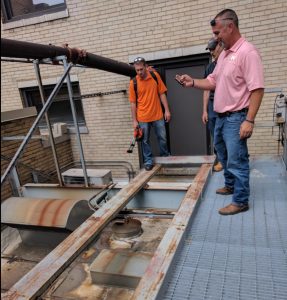




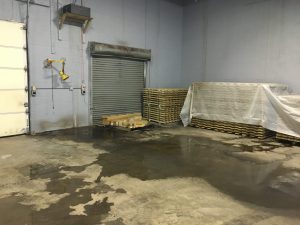
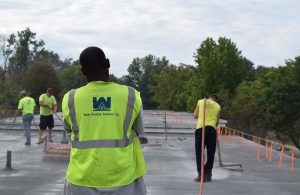 Commercial Roofing Maintenance and Repair Services[/caption]
Commercial Roofing Maintenance and Repair Services[/caption]


